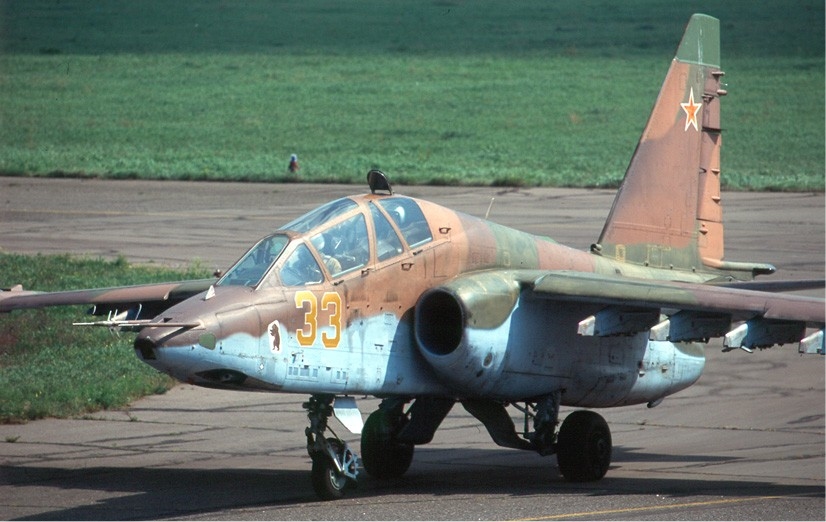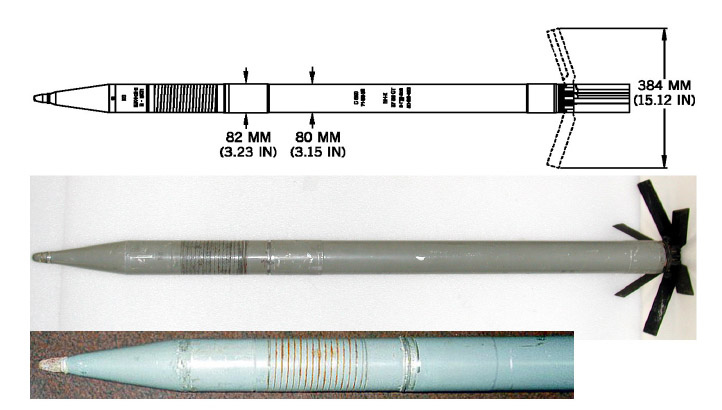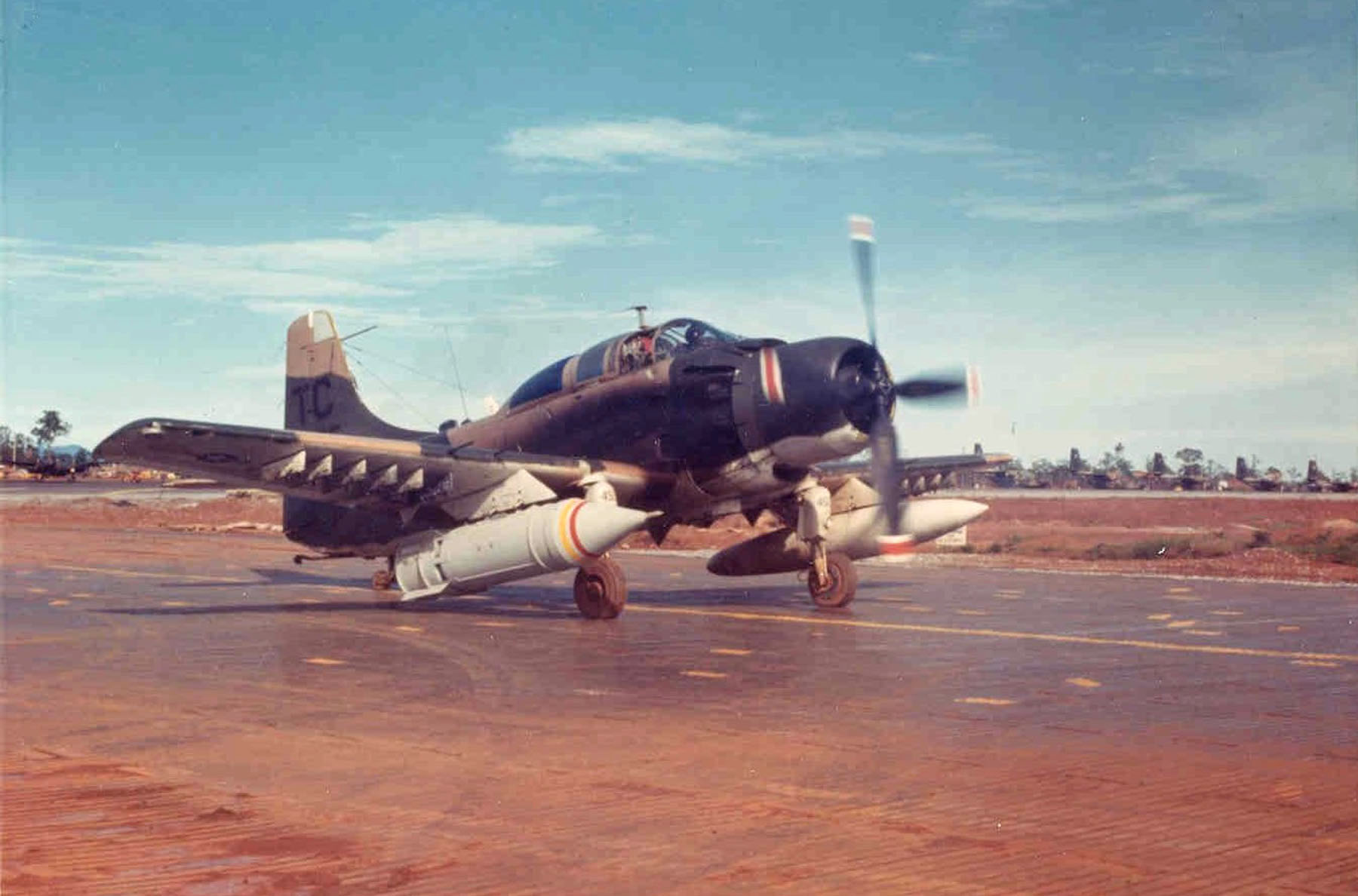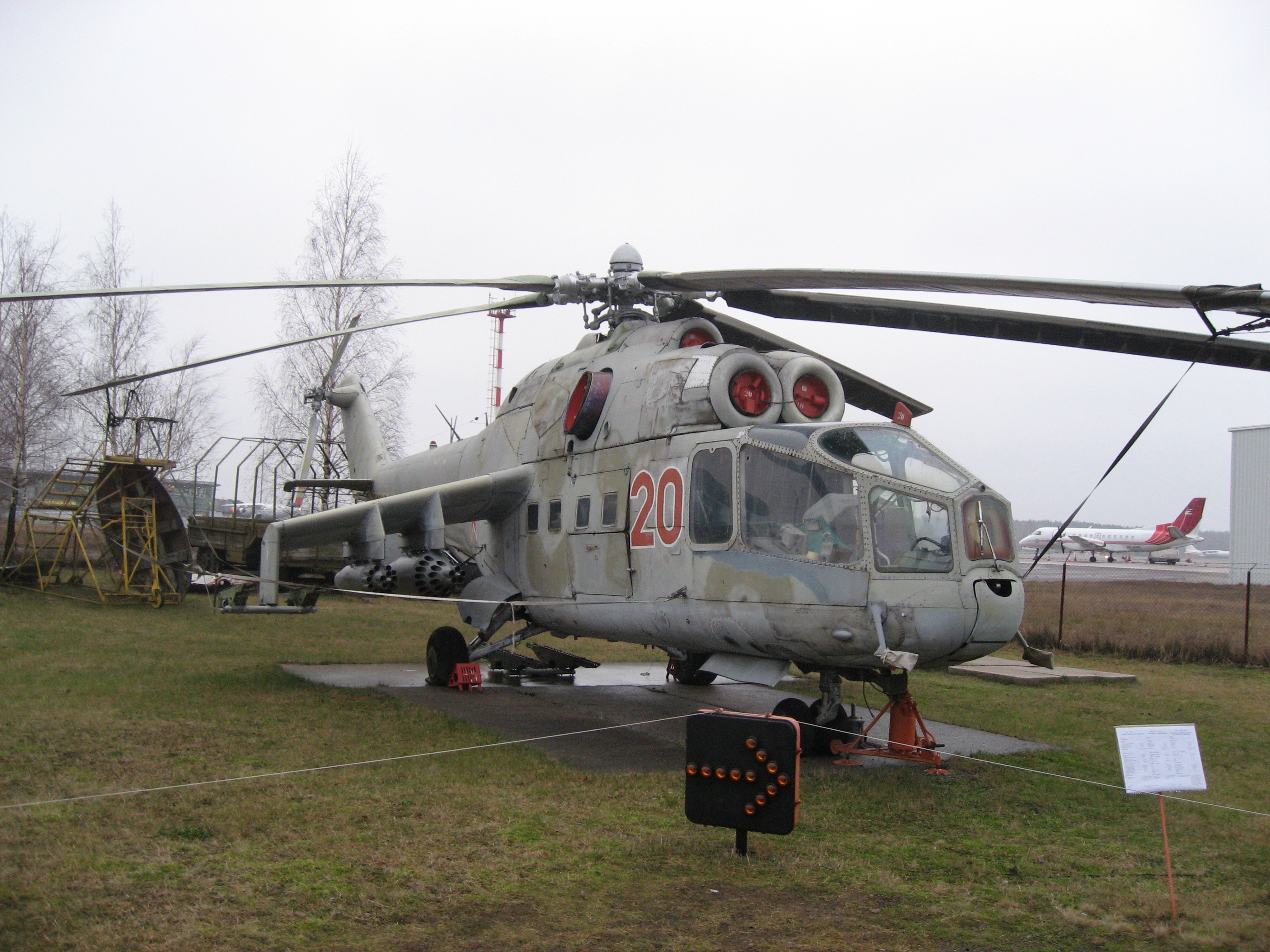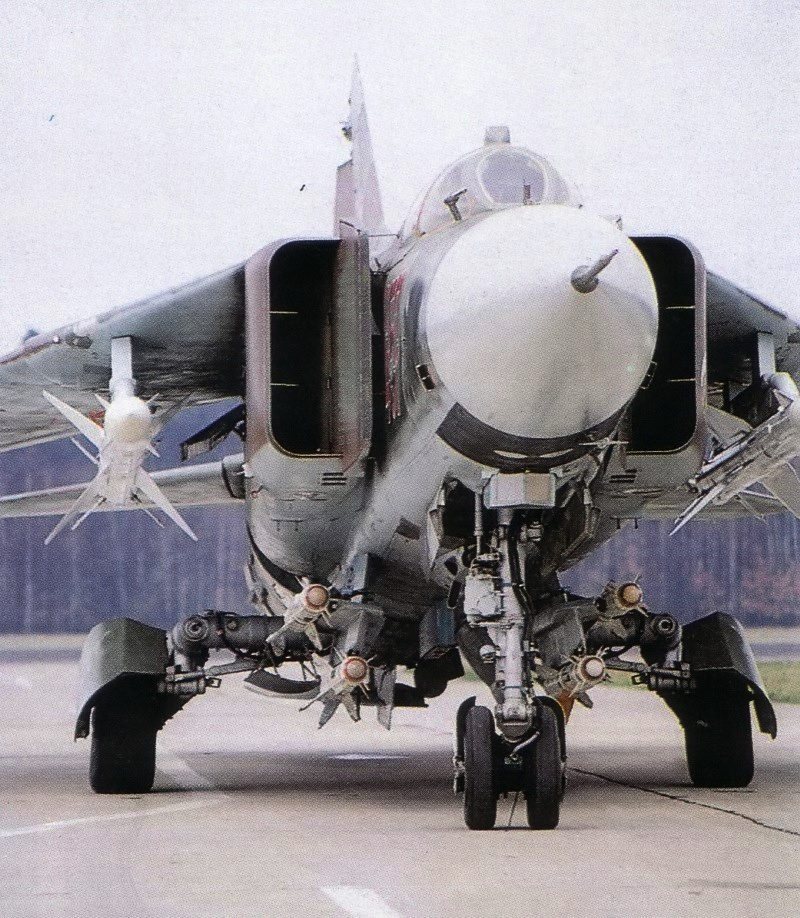|
S-13 Rocket
The S-13 is a 122 mm calibre unguided rocket weapon developed by the Soviet Air Force for use by military aircraft. It remains in service with the Russian Aerospace Forces and some other countries. Development The S-13 rocket was developed in the 1970s to meet requirements for a penetrating weapon capable of cratering runways and penetrating hardened aircraft shelters, bunkers and pillboxes, to fill a gap between 80 mm and 240 mm rockets and fulfill a role similar to the 127 mm Zuni rocket. The S-13 is conventional in layout, with a solid rocket motor and folding tail fins that provide stability after launch. The first trials were in 1973, but it was introduced only in 1983. S-13 rockets are shot from 5-tube launchers B-13L, that can be carried by most of Soviet and Russian attack and new fighter aircraft, like Sukhoi Su-17/20/22, Sukhoi Su-24, Sukhoi Su-25, Sukhoi Su-27, MiG-23BN, MiG-27, MiG-29. B-13L1 launcher is used by helicopters such as Mil Mi-24, ... [...More Info...] [...Related Items...] OR: [Wikipedia] [Google] [Baidu] |
Sukhoi Su-25
The Sukhoi Su-25 ''Grach'' ( ('' rook''); NATO reporting name: Frogfoot) is a subsonic, single-seat, twin-engine jet aircraft developed in the Soviet Union by Sukhoi. It was designed to provide close air support for Soviet Ground Forces. The first prototype made its maiden flight on 22 February 1975. After testing, the aircraft went into series production in 1978 in Tbilisi in the Georgian Soviet Socialist Republic. Early variants included the Su-25UB two-seat trainer, the Su-25BM for target-towing, and the Su-25K for export customers. Some aircraft were upgraded to the Su-25SM standard in 2012. The Su-25T and the Su-25TM (also known as the Su-39) were further developments, not produced in significant numbers. The Su-25, and the Su-34, were the only armoured, fixed-wing aircraft in production in 2007.Gordon and Dawes 2004. Su-25s are in service with Russia, other CIS members, and export customers. Production of the Su-25 ended in 2010 in Georgia. Attempts continue to b ... [...More Info...] [...Related Items...] OR: [Wikipedia] [Google] [Baidu] |
Zuni (rocket)
The Zuni 5-inch Folding-Fin Aircraft Rocket (FFAR), or simply Zuni, is a unguided rocket developed by the Hunter Douglas Division of Bridgeport Brass Company and deployed by the United States Armed Forces, and the French Air Force. The rocket was developed for both air-to-air and air-to-ground operations. It can be used to carry various types of warheads, including chaff for countermeasures. It is usually fired from the LAU-10 rocket pod holding four rockets. Development In the early 1950s, U.S. Navy engineers at Naval Ordnance Test Station China Lake began to develop a new 12.7 cm unguided rocket to replace the High Velocity Aircraft Rocket. The Zuni was designed as a modular system, to allow the use of different types of warheads and fuzes. One type of warhead had a proximity fuze, as the rocket was originally intended to be used as an air-to-air rocket. This led to its selection as the basis for the AIM-9 Sidewinder airframe in the early 1950s. The Zuni was approved ... [...More Info...] [...Related Items...] OR: [Wikipedia] [Google] [Baidu] |
S-8 Rocket
The S-8 is a rocket weapon developed by the Soviet Air Force for use by military aircraft. It remains in service with the Russian Aerospace Forces and various export customers. Developed in the 1970s, the S-8 is an 80 mm (3.1 in) rocket used by fighter bombers and helicopters. The system entered service in 1984 and is produced in a variety of subtypes with different warheads, including HEAT anti-armor, high-explosive fragmentation, smoke, and incendiary, as well as the specialized S-8BM runway-destroying munition and the S-8DM fuel-air explosive variants. Each rocket is between 1.5 meters (4 ft 11 in) and 1.7 meters (5 ft 7 in) long and weighs between 11.3 kg (25 lb) and 15.2 kg (33.5 lb), depending on warhead and fuse. Range is 2 to 4 kilometers (1.3 to 2.6 mi). The S-8 is generally carried in the B series of rocket pods, carrying either seven or 20 rockets. In 2018, the Russian Aerospace Forces took delivery and completed state tes ... [...More Info...] [...Related Items...] OR: [Wikipedia] [Google] [Baidu] |
Thermobaric Weapon
A thermobaric weapon, also called an aerosol bomb, or a vacuum bomb, is a type of explosive munition that works by dispersing an aerosol cloud of gas, liquid or powdered explosive. The fuel is usually a single compound, rather than a mixture of multiple substances. Many types of thermobaric weapons can be fitted to hand-held launchers, and can also be launched from airplanes. Terminology The term ''thermobaric'' is derived from the Greek words for 'heat' and 'pressure': ''thermobarikos'' (θερμοβαρικός), from ''thermos'' (θερμός) 'hot' + ''baros'' (βάρος) 'weight, pressure' + suffix ''-ikos'' (-ικός) '-ic'. Other terms used for the family of weapons are high-impulse thermobaric weapons, heat and pressure weapons, vacuum bombs, and fuel-air explosives (FAE). Mechanism File:Dust explosion 00.jpg, Experimental setup File:Dust explosion 01.jpg, Finely-ground flour is dispersed File:Dust explosion 02.jpg, Cloud of flour is ignited File:Dust explosion 03. ... [...More Info...] [...Related Items...] OR: [Wikipedia] [Google] [Baidu] |
HEAT
In thermodynamics, heat is energy in transfer between a thermodynamic system and its surroundings by such mechanisms as thermal conduction, electromagnetic radiation, and friction, which are microscopic in nature, involving sub-atomic, atomic, or molecular particles, or small surface irregularities, as distinct from the macroscopic modes of energy transfer, which are thermodynamic work and transfer of matter. For a closed system (transfer of matter excluded), the heat involved in a process is the difference in internal energy between the final and initial states of a system, after subtracting the work done in the process. For a closed system, this is the formulation of the first law of thermodynamics. Calorimetry is measurement of quantity of energy transferred as heat by its effect on the states of interacting bodies, for example, by the amount of ice melted or by change in temperature of a body. In the International System of Units (SI), the unit of measurement for he ... [...More Info...] [...Related Items...] OR: [Wikipedia] [Google] [Baidu] |
Yakovlev Yak-130
The Yakovlev Yak-130 (NATO reporting name: Mitten) is a Subsonic aircraft, subsonic two-seat advanced jet trainer and light combat aircraft originally developed by Yakovlev and Aermacchi as the "Yak/AEM-130". It has also been marketed as a potential light attack aircraft. Development of the aircraft began in 1991 and the maiden flight was conducted on 25 April 1996. In 2002, it won a Russian government tender for training aircraft and in 2010 the aircraft entered service with the Russian Air Force. As an advanced training aircraft, the Yak-130 is able to replicate the characteristics of several 4+ generation fighters as well as the fifth-generation Sukhoi Su-57. It can also perform light-attack and reconnaissance duties, carrying a combat load of . Development In the early 1990s, the Soviet government asked the industry to develop a new aircraft to replace the Czech-made Aero L-29 Delfín and Aero L-39 Albatros jet trainers. Five design bureaus put forward proposals. Among them ... [...More Info...] [...Related Items...] OR: [Wikipedia] [Google] [Baidu] |
Sukhoi Su-35
The Sukhoi Su-35 (-35; NATO reporting name: Flanker-E/M, occasionally nicknamed "Super Flanker") is the designation for two improved derivatives of the Sukhoi Su-27, Su-27 air-defence fighter. They are single-seat, twinjet, twin-engine, supermaneuverability, supermaneuverable, 4.5 generation air superiority fighters, designed by the Sukhoi Design Bureau and built by Sukhoi. The type was originally developed by the Soviet Union from the Su-27 and was known as the Su-27M. It incorporated Canard (aeronautics), canards and a multi-function radar giving it multi-role capabilities. The first prototype made its maiden flight in June 1988. Following the dissolution of the Soviet Union Sukhoi re-designated it as the Su-35 to attract export orders. Fourteen aircraft were produced and used for tests and demonstrations; one example had Thrust vectoring, thrust-vectoring engines and was in turn redesignated the Sukhoi Su-37, Su-37. A sole Su-35UB two-seat trainer was also built in the late ... [...More Info...] [...Related Items...] OR: [Wikipedia] [Google] [Baidu] |
Sukhoi Su-30
The Sukhoi Su-30 (; NATO reporting name: Flanker-C/G/H) is a twin-engine, two-seat supermaneuverable fighter aircraft developed in the Soviet Union in the 1980s by Russia's Sukhoi Aviation Corporation. It is a multirole fighter for all-weather, air-to-air interdiction missions. The Russian Aerospace Forces (VKS) were reported to have 130 Su-30SMs in operation as of 2024. The Su-30 started as an internal development project in the Sukhoi Su-27 family by Sukhoi. From the Su-27UB two-seat trainer, the Su-27PU heavy interceptor was developed. The design plan was revamped and the Su-27PU was renamed to Su-30 by the Russian Defense Ministry in 1996. Of the Flanker family, the Su-27, Su-30, Su-33, Su-34 and Su-35 have been ordered into limited or serial production by the Russian Defense Ministry. Later, different export requirements split the Su-30 into two distinct version branches, manufactured by competing organizations: KnAAPO and the Irkut Corporation, both of which come un ... [...More Info...] [...Related Items...] OR: [Wikipedia] [Google] [Baidu] |
Kamov Ka-52
The Kamov Ka-50 "Black Shark" (, English: kitefin shark), NATO reporting name Hokum A, is a Soviet/Russian single-seat attack helicopter with the distinctive coaxial rotor system of the Kamov design bureau. It was designed in the 1980s and adopted for service in the Russian army in 1995. The Ka-50 is manufactured by the Progress company in Arsenyev. It is used as a heavily armed scout helicopter and has a rescue ejection system, rare for helicopters. During the late 1990s, Kamov and Israel Aerospace Industries developed a tandem-seat cockpit version, the Kamov Ka-50-2 "Erdogan" (, ), to compete in Turkey's attack helicopter competition. Kamov also designed another two-seat variant, the Kamov Ka-52 "Alligator" (, NATO reporting name: Hokum B). The Ka-52's unit cost is US$16 million as of 2023. Development The Ka-50 is the production version of the V-80Sh-1 prototype. Production of the attack helicopter was ordered by the Soviet Council of Ministers on 14 De ... [...More Info...] [...Related Items...] OR: [Wikipedia] [Google] [Baidu] |
Mil Mi-28
The Mil Mi-28 (NATO reporting name "Havoc") is a Soviet all-weather, day-night, military tandem, two-seat anti-armor attack helicopter. It is an attack helicopter with no intended secondary transport capability, and is better optimized than the Mil Mi-24 gunship for the role. It carries a single gun in an undernose barbette, plus external loads carried on pylons beneath stub wings. Development Origins In 1972, following the completion of the Mil Mi-24, development began on a unique attack helicopter with transport capability. The new design had a reduced transport capability (3 troops instead of 8) and omitted the cabin to provide better overall performance and higher top speed. Improved performance was important for its intended role fighting against tanks and enemy helicopters and covering helicopter landing operations. Initially, many different designs were considered, including an unconventional project with two main rotors, placed with engines on tips of wings (in perp ... [...More Info...] [...Related Items...] OR: [Wikipedia] [Google] [Baidu] |
Mil Mi-24
The Mil Mi-24 (; NATO reporting name: Hind) is a large helicopter gunship, attack helicopter and low-capacity transport helicopter, troop transport with room for eight passengers. It is produced by Mil Moscow Helicopter Plant and was introduced by the Soviet Air Forces, Soviet Air Force in 1972. The helicopter is currently in use by 58 countries. In NATO circles, the export versions, Mi-25 and Mi-35, are denoted with a letter suffix as "Hind D" and "Hind E". Soviet pilots called the Mi-24 the "flying tank" (), a term used historically with the famous World War II Soviet Ilyushin Il-2#"The Flying tank", Il-2 ''Shturmovik'' armored ground attack aircraft. Other common unofficial nicknames were "Galina" (or "Galya"), "Crocodile" (), due to the helicopter's camouflage scheme, and "faceted glass, Drinking Glass" (), because of the flat glass plates that surround earlier Mi-24 variants' cockpits. Development During the early 1960s, it became apparent to Soviet designer Mikhail Mil th ... [...More Info...] [...Related Items...] OR: [Wikipedia] [Google] [Baidu] |
MiG-23
The Mikoyan-Gurevich MiG-23 (; NATO reporting name: Flogger) is a variable-geometry fighter aircraft, designed by the Mikoyan-Gurevich design bureau in the Soviet Union. It is a third-generation jet fighter, alongside similar Soviet aircraft such as the Su-17 "Fitter". It was the first Soviet fighter to field a look-down/shoot-down radar, the RP-23 Sapfir, and one of the first to be armed with beyond-visual-range missiles. Production started in 1969 and reached large numbers with over 5,000 aircraft built, making it the most produced variable-sweep wing aircraft in history. The MiG-23 remains in limited service with some export customers. The basic design was also used as the basis for the Mikoyan MiG-27, a dedicated ground-attack variant. Among many minor changes, the MiG-27 replaced the MiG-23's nose-mounted radar system with an optical panel holding a laser designator and a TV camera. Development The MiG-23's predecessor, the MiG-21, was fast and agile, but limited ... [...More Info...] [...Related Items...] OR: [Wikipedia] [Google] [Baidu] |
